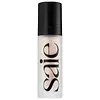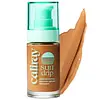What's inside
What's inside
 Key Ingredients
Key Ingredients

 Benefits
Benefits

 Concerns
Concerns

 Ingredients Side-by-side
Ingredients Side-by-side

Water
Skin ConditioningCaprylic/Capric Triglyceride
MaskingPropanediol
SolventGlycerin
HumectantMica
Cosmetic ColorantHydroxyethyl Acrylate/Sodium Acryloyldimethyl Taurate Copolymer
Emulsion StabilisingSqualane
EmollientCaprylyl Glycol
EmollientPhenethyl Alcohol
MaskingEthylhexylglycerin
Skin ConditioningPolysorbate 60
EmulsifyingAscorbyl Tetraisopalmitate
AntioxidantCarica Papaya Seed Oil
HumectantRosa Canina Fruit Oil
EmollientLactic Acid
BufferingCI 77891
Cosmetic ColorantCI 77491
Cosmetic ColorantWater, Caprylic/Capric Triglyceride, Propanediol, Glycerin, Mica, Hydroxyethyl Acrylate/Sodium Acryloyldimethyl Taurate Copolymer, Squalane, Caprylyl Glycol, Phenethyl Alcohol, Ethylhexylglycerin, Polysorbate 60, Ascorbyl Tetraisopalmitate, Carica Papaya Seed Oil, Rosa Canina Fruit Oil, Lactic Acid, CI 77891, CI 77491
Water
Skin ConditioningHydrogenated Polyisobutene
EmollientGlycerin
HumectantGlyceryl Oleate Citrate
EmulsifyingHydroxyethyl Acrylate/Sodium Acryloyldimethyl Taurate Copolymer
Emulsion StabilisingMica
Cosmetic ColorantCoco-Caprylate
EmollientPhenoxyethanol
PreservativeButylene Glycol
HumectantCaprylic/Capric Triglyceride
MaskingBoron Nitride
AbsorbentSodium Benzoate
MaskingTocopherol
AntioxidantSorbitan Isostearate
EmulsifyingEthylhexylglycerin
Skin ConditioningCarbomer
Emulsion StabilisingSodium Lactate
BufferingGalactoarabinan
Polysorbate 20
EmulsifyingPentylene Glycol
Skin ConditioningGlycine Soja Oil
EmollientPhospholipids
Skin ConditioningPhytosterols
Skin ConditioningPalmitoyl Tripeptide-1
Skin ConditioningLeuconostoc/Radish Root Ferment Filtrate
AntimicrobialPalmitoyl Tetrapeptide-7
Skin ConditioningSodium Hyaluronate Crosspolymer
HumectantUbiquinone
AntioxidantIron Oxides
Titanium Dioxide
Cosmetic ColorantCI 77891
Cosmetic ColorantWater, Hydrogenated Polyisobutene, Glycerin, Glyceryl Oleate Citrate, Hydroxyethyl Acrylate/Sodium Acryloyldimethyl Taurate Copolymer, Mica, Coco-Caprylate, Phenoxyethanol, Butylene Glycol, Caprylic/Capric Triglyceride, Boron Nitride, Sodium Benzoate, Tocopherol, Sorbitan Isostearate, Ethylhexylglycerin, Carbomer, Sodium Lactate, Galactoarabinan, Polysorbate 20, Pentylene Glycol, Glycine Soja Oil, Phospholipids, Phytosterols, Palmitoyl Tripeptide-1, Leuconostoc/Radish Root Ferment Filtrate, Palmitoyl Tetrapeptide-7, Sodium Hyaluronate Crosspolymer, Ubiquinone, Iron Oxides, Titanium Dioxide, CI 77891
 Reviews
Reviews

Ingredients Explained
These ingredients are found in both products.
Ingredients higher up in an ingredient list are typically present in a larger amount.
This ingredient is an emollient, solvent, and texture enhancer. It is considered a skin-softener by helping the skin prevent moisture loss.
It helps thicken a product's formula and makes it easier to spread by dissolving clumping compounds.
Caprylic Triglyceride is made by combining glycerin with coconut oil, forming a clear liquid.
While there is an assumption Caprylic Triglyceride can clog pores due to it being derived from coconut oil, there is no research supporting this.
Learn more about Caprylic/Capric TriglycerideCi 77891 is a white pigment from Titanium dioxide. It is naturally found in minerals such as rutile and ilmenite.
It's main function is to add a white color to cosmetics. It can also be mixed with other colors to create different shades.
Ci 77891 is commonly found in sunscreens due to its ability to block UV rays.
Learn more about CI 77891Ethylhexylglycerin (we can't pronounce this either) is commonly used as a preservative and skin softener. It is derived from glyceryl.
You might see Ethylhexylglycerin often paired with other preservatives such as phenoxyethanol. Ethylhexylglycerin has been found to increase the effectiveness of these other preservatives.
Glycerin is already naturally found in your skin. It helps moisturize and protect your skin.
A study from 2016 found glycerin to be more effective as a humectant than AHAs and hyaluronic acid.
As a humectant, it helps the skin stay hydrated by pulling moisture to your skin. The low molecular weight of glycerin allows it to pull moisture into the deeper layers of your skin.
Hydrated skin improves your skin barrier; Your skin barrier helps protect against irritants and bacteria.
Glycerin has also been found to have antimicrobial and antiviral properties. Due to these properties, glycerin is often used in wound and burn treatments.
In cosmetics, glycerin is usually derived from plants such as soybean or palm. However, it can also be sourced from animals, such as tallow or animal fat.
This ingredient is organic, colorless, odorless, and non-toxic.
Glycerin is the name for this ingredient in American English. British English uses Glycerol/Glycerine.
Learn more about GlycerinThis is a synthetic polymer. It helps improve the texture of products by adding thickness and gel-like feel.
It is also an emulsifer, meaning it prevents ingredients such as oil and water from separating. It also helps evenly disperse other ingredients.
Mica is a naturally occurring mineral used to add shimmer and color in cosmetics. It can also help improve the texture of a product or give it an opaque, white/silver color.
Serecite is the name for very fine but ragged grains of mica.
This ingredient is often coated with metal oxides like titanium dioxide. Trace amounts of heavy metals may be found in mica, but these metals are not harmful in our personal products.
Mica has been used since prehistoric times throughout the world. Ancient Egyptian, Indian, Greek, Roman, Aztec, and Chinese civilizations have used mica.
Learn more about MicaWater. It's the most common cosmetic ingredient of all. You'll usually see it at the top of ingredient lists, meaning that it makes up the largest part of the product.
So why is it so popular? Water most often acts as a solvent - this means that it helps dissolve other ingredients into the formulation.
You'll also recognize water as that liquid we all need to stay alive. If you see this, drink a glass of water. Stay hydrated!
Learn more about Water